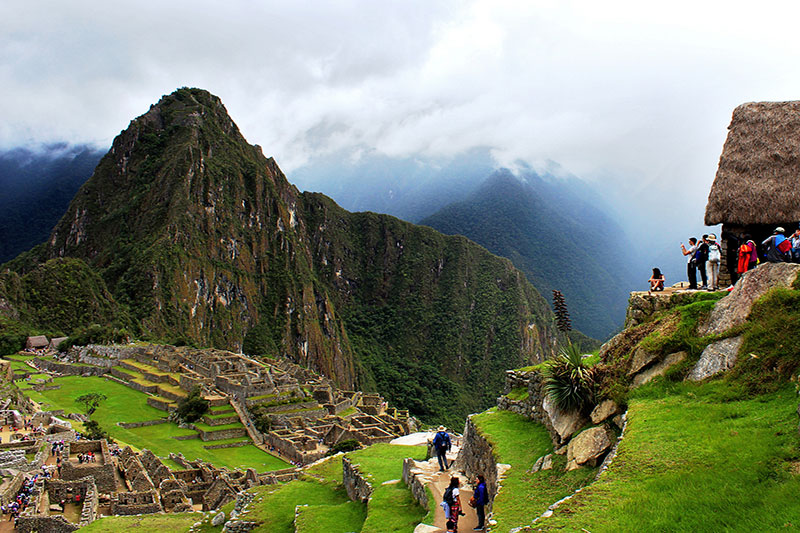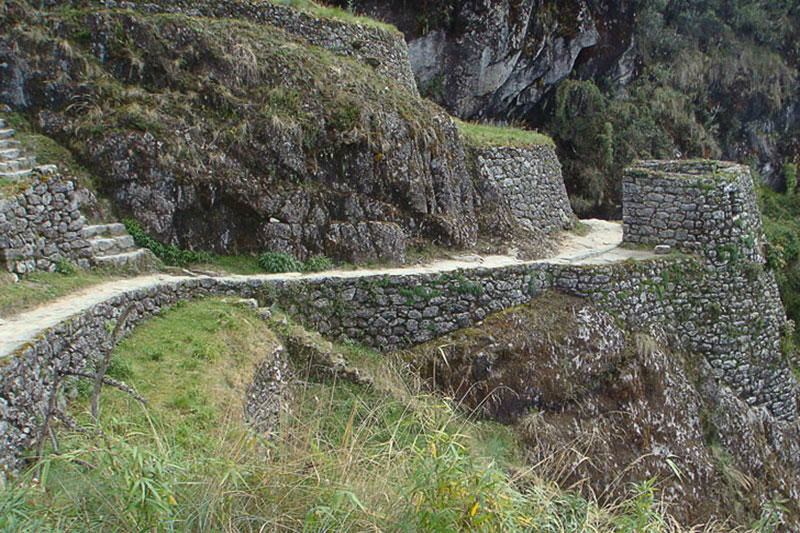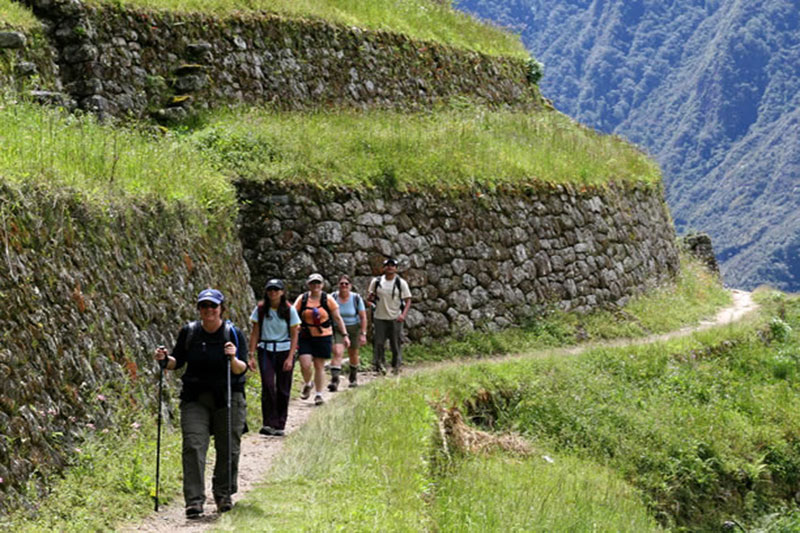10 things you should know about the Inca Trail
The Inca Trail is one of the 5 best hikes in the world and Machu Picchu is the end point of this amazing journey. This hiking trail is the most amazing way to have the first sight of the Wonder of the World, as the Incas did almost 600 years ago.
If you chose to enter the Wonder of the World for this amazing trekking route, there are 10 things you should know.
- 1 – When to book the Inca Trail to Machu Picchu?
- 2 – How long is the tour of the Inca Trail?
- 3 – What is the maximum height of the Inca Trail?
- 4 – Can I do the Inca Trail on my own?
- 5 – Is the Inca Trail open all year?
- 6 – What is the best time to do the Inca Trail?
- 7 – Does the hike have to be 4 days?
- 8 – Is the Inca Trail dangerous?
- 9 – Can I do the Inca Trail with children?
- 10 – How much does the Inca Trail cost?
- More information about the Inca Trail

Go by train to Machu Picchu, it’s a spectacular trip
1 – When to book the Inca Trail to Machu Picchu?
The Inca Trail is one of the best walks on the planet. That is why there is a great demand for tickets. That is why you must reserve your income well in advance.
Take into account the following before booking the ticket to the Inca Trail:
- The income to the Inca Trail is exhausted 6 months before. Remember that only 500 people can travel this route every day.
- Only 200 people will end up entering Machu Picchu in this way, since the rest belong to the support team, chefs, porters and guides.
- The entrance to the Inca Trail only includes the Inca City of Machu Picchu. If you want to tour the Machu Picchu Mountain or the Huayna Picchu; ask for it at the tourist agency.
- The purchase of the income to the Inca Trail is through the website of an authorized tourism agency.
Any tour to the Inca Trail must include the following: entrance to Machu Picchu, cooks, porters, camp, tour guide and return to Cusco (by bus and train).
2 – How long is the tour of the Inca Trail?
The Classic or Traditional Inca Trail is 40 kilometers away and 4 days of hiking (approximately 18 to 24 hours). The route will take you through mountains, until arriving at Machu Picchu in the Amazon jungle of Peru.
Some information about the tour of the Inca Trail:
- The route crosses archaeological sites such as Llactapata, Runkurakay, Sayacmarca, Phuyupatamarca and Wiñaywayna.
- The end of the road is the entrance to Machu Picchu by the Intipunku (Puerta del Sol). That was the main gate in the time of the Incas. The landscape there is incredible.
- In most cases, after traveling the Inca Trail, you will return to Cusco by train.
- The only way to hike the Inca Trail is to buy a tour through a tourist agency that has the corresponding permit.
- No tourist can walk the Inca Trail without authorization. The tourist agencies are in charge of processing the authorization for the visitor.
3 – What is the maximum height of the Inca Trail?
The Inca Trail is considered a difficult expedition not only because of the distance but because of the high altitude at some point along the way.The highest point of the road is in the ‘Abra Warmihuañusca’, at 4,224 meters (13,860 feet).
Recommendations on the problems with the height in the Inca Trail:
- Altitude sickness or soroche is a typical malaise in places of high altitudes. It can cause headaches, nausea, loss of appetite and lack of energy.
- The best thing to fight the soroche is to spend a few days of acclimatization in Cusco or the Sacred Valley of the Incas.
- However, at the end of the trail, it also passes through lower altitude sites such as Intipata (2,743 m.a.s.l.), Intipunku (2,700 m.a.s.l.) or Machu Picchu itself (2,400 m.a.s.l.).
- One of the most effective ways is to drink plenty of coca tea (infusion made from coca leaves) or chew it, as the Incas did hundreds of years ago.
- In any case, the tour guide has a lot of experience in these discomforts and they will know how to help the visitor during the Inca Trail.

Inca remains on the Inca Trail
4 – Can I do the Inca Trail on my own?
The entrance to the legendary Inca highway is strictly controlled. This seeks to protect the Inca Trail of more than 500 years old and the wonderful natural environment that surrounds it.
More information about the permits of the Inca Trail:
- The Inca Trail is only allowed with the company of a tour guide. The purchase of the income is in an authorized travel agency.
- The agency will arrange to book the entrance ticket for you and everything you need to do the Inca Trail.
- Tickets must be reserved 6 months in advance. Permits are limited to 500 people per day.
- Among the 500 people who carry out the Inca Trail, chefs, porters and guides are included. So there are only 200 tourists who can enter Machu Picchu by the Inca Trail.
5 – Is the Inca Trail open all year?
The Inca Trail is closed in February. During that month, the rains are stronger and can make it very difficult to walk the trails of the Inca Trail. The guards take advantage of those days to maintain the road and the Inca structures. The rest of the year, this hiking trail remains open to the public.
Alternatives to get to Machu Picchu with hiking trails:
- The Salkantay Trek is one of the alternative routes to Machu Picchu. It lasts 5 days and 4 nights and goes through the famous Salkantay snowcapped mountains as well as jungle landscapes.
- The hiking trail that connects Choquequirao with Machu Picchu is an 8- or 9-day trek that connects Cusco with the 2 most beautiful Inca archaeological sites in Cusco.
- The Lares Trek is a 4-day, 3-night hike through high-altitude landscapes until arriving at Machu Picchu. There are several variants of this hiking trail.
- The Huchuy Qosqo trek is a simple route of only 3 days and 2 nights that covers only 17 kilometers and ends in Machu Picchu. It is recommended for the whole family.
6 – What is the best time to do the Inca Trail?
Cusco and the entire southern region of Peru are marked by two distinct climatic seasons: the rainy season (from November to March) and the dry season (from April to October). The best time to do the Inca Trail is the dry season. The climate in those months is warm and with little frequency of rains.
What to bring to combat the climate on the Inca Trail?
- If you plan to visit the Inca Trail during the dry season, it is advisable to bring a hat, sunscreen, mosquito repellent, sunglasses, light clothing during the day and warm at night.
- If you plan to visit the Inca Trail during the rainy season, it is recommended to bring a raincoat, windbreaker, anti-slip shoes and walking stick.
During the Inca Trail, the temperature can reach 25ºC. During the dry season, mosquitoes abound here, which can be very annoying.
7 – Does the hike have to be 4 days?
There is a short version of the Inca Trail that lasts 2 days.This option is ideal for travelers who do not have enough time to make the 4-day route.It often includes one night in a comfortable establishment instead of the camp.
More information about the alternative Inca Trail:
- There are many alternative treks to Machu Picchu such as the Salkantay Trek or the Lares Trek. However, the Inca Trail is the only one that will take you directly to the Inca City through the Intipunku (Puerta del Sol).
- The 2-day Inca Trail covers only 12 kilometers to Machu Picchu through the Intipunku sector. However, that day you spend the night in a lodge in Aguas Calientes. The next day you will visit the archaeological site of Machu Picchu.
- The availability of income to the alternative Inca Trail does not have as much demand as the classic version. It can be booked 2 or 3 weeks in advance.

Tourists on the Inca Trail
8 – Is the Inca Trail dangerous?
The Inca Trail is not dangerous. The security measures provided include first aid equipment. Tourism guides are trained to act effectively in any type of emergency.
What dangers can there be in the Inca Trail?
- The trails of the Inca Trail are wide and well signposted. For no reason should the tourist risk his life looking for roads on his own.
- Many tourists are afraid to do the Inca Trail for fear of suffering from altitude sickness, however, the symptoms of altitude sickness usually disappear as soon as acclimatization to the mountains is achieved.
- Older adults can feel more intense physical wear during the Inca Trail. They should consult with their doctor before doing the walk.
- Children should be under the watchful eye of their parents. It is recommended that children enjoy walking or physical activities outdoors.
9 – Can I do the Inca Trail with children?
The Inca Trail is allowed to people of any age. Children or teenagers can take the walk accompanied by their parents. It is preferable that minors like long walks and camps.
Tips to make the Inca Trail with children
- It is not advisable to do the Inca Trail with children under 8 years old, unless they have already satisfactorily completed similar walks.
- Of course it is not advisable to do the Inca Trail with babies.
- If you have already decided to do the Inca Trail with children, it is advisable to prepare them psychologically for the journey.
Are there toilets during the Inca Trail? Yes. These are established in each of the three camps. Most are used in the ‘squat’ form. Only in the last camp there is a shower service.
10 – How much does the Inca Trail cost?
The Inca Trail is organized by groups of a maximum of 16 tourists. These people are of different nationalities, ages and cultures.
The prices of the Inca Trail vary according to each tourist agency.It is estimated that on average, the 4-day tour costs 600 USD per person.
How to get the best price to the Inca Trail?
- Most tour agencies offer a $20 or $30 discount for university students with a valid student ID card (ISIC card is not allowed).
- Children under 18 also have an approximate discount by presenting a passport that certifies their age.
- Some tourist agencies also offer discounts for citizens of Peru, Colombia, Ecuador and Bolivia.
- The cost of the Inca Trail in private service depends on the number of tourists in a group. The more tourists, the lower the cost.
More information about the Inca Trail
- The return to Cusco – After visiting Machu Picchu with the Inca Trail, the return is with a train trip from Aguas Calientes to Ollantaytambo. From there, a minivan transports tourists to the city of Cusco.
- The porters – The porters are local people in charge of transporting the food and the camping equipment and the extra luggage of the tourists in order to provide greater comfort during the trip.
- The cooks – The cooks are also local people who specialize in preparing nutritious and delicious dishes for the tourists at each camp. If the tourist requests it in advance, the menu can include an option for vegetarians.
- Tipping – Tips are directed to the tour guide, porters and cooks. Although not required, it has become a tradition to provide this gratuity.
- The camps – There are 3 camps established during the trek: Ayapata, Chaquicocha and Wiñayhuayna. However, these may vary based on availability. To get the most recommended camps, it is advisable to buy the tour approximately 6 months in advance.
- Availability – The Inca Trail offers an availability of only 200 people per day. Due to the high demand for this tour, it is recommended to purchase the service online 6 months in advance. Otherwise you will not find availability. The purchase can be made through the website of a tourism agency.
- Archaeological sites – Along the Inca Trail there are Inca archaeological sites such as: Llactapata, Runkurakay, Sayacmarca, Phuyupatamarca and Wiñayhuayna. These sites have a historical importance and scenic beauty similar to Machu Picchu.
- The tourist agencies – There are many tourist agencies that offer the 4-day Inca Trail tour. Which to choose? It is best to choose an agency that has good comments on their social networks in internet tourism forums (such as TripAdvisor).
By Ticket Machu Picchu – Last updated, August 15, 2024